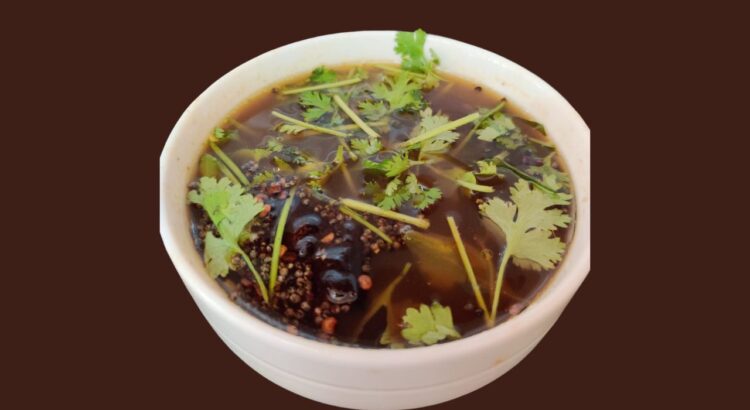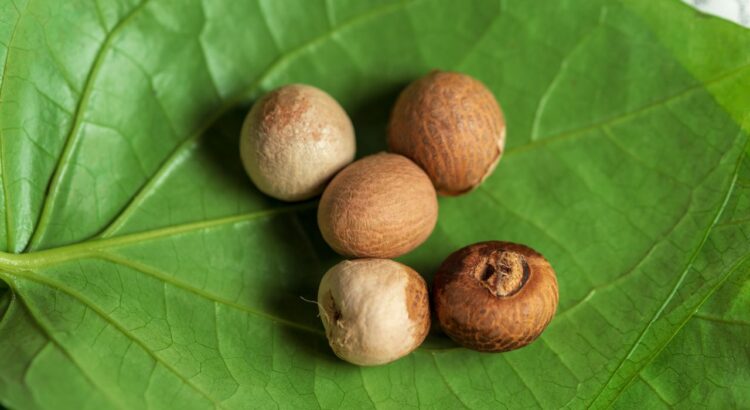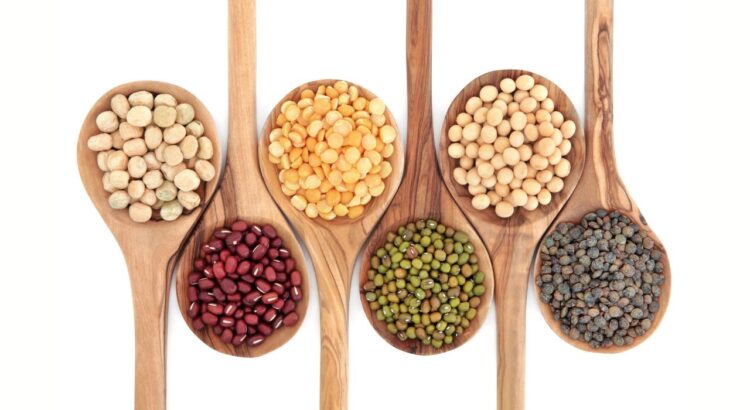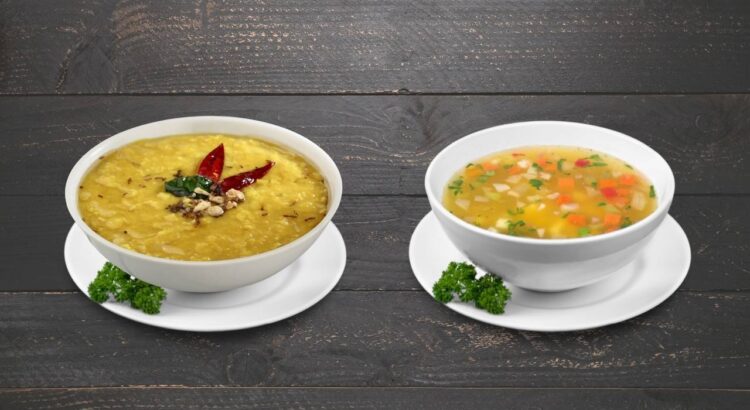Yusha are liquidy, cooked soups made of vegetables or pulses. In contrast to kichari, a rice-dahl stew, or yavagu, rice-water-spices stews that are prescribed medicinally, the yusha focus on the vegetable or pulse at the center of the dish.
Of the 22 yushas (यूष) described in detail in the ancient text Kaiyadeva Nighantu, six are especially described for their medicinal effects. The first of these six is mudgayusha, made of the most useful and medicinal bean, known in Sanskrt as mudga. Its main therapeutic property is to safely stimulate the digestive fire.
The mudga bean is also known as the green gram, the mūng bean, and the moong dahl. The green gram is an annual vine with yellow flowers and fuzzy brown pods that grows in warm seasons and is frost-intolerant. The pods are elongated or flat cylindrical and are the fruits of the plant. There are usually 30-50 pods per plant. Each pod is 5–10 cm long (1-2 inches long) x 0.4-0.6 cm wide and contains 12-14 seeds separated by a septum. The seeds can have hues of green, yellow, brown or blue depending on the soil, season, and sun, and can be more cylindrical or more spherical in shape. These seed colors along with the presence or absence of a rough layer coat distinguish different subtypes of the mung bean.
Mung beans are recognized for their high nutritive value. Mung beans contain about 55%-65% carbohydrate, calculated to about 63% of the dry weight of the bean and can contain 20%-50% protein in the dry bean. The two main storage proteins of the mung bean are globulin and albumin, which makes it a a substantive source of dietary proteins that are easily digestible, leading to less flatulence in humans compared to other forms of legumes. The mung bean is also rich in vitamins and minerals.
Mung beans have been known to Asia for thousands of years. Carbonized mung beans were discovered in several archeological sites in India, including the eastern zone of the Harappan civilisation in northwestern India, and in archeological sites in Karnataka where mung beans have been dated back to 2,500 years BCE.
Of the śimbi-dhānyās (beans that grow in pods), mudga is the most excellent. Like the other beans -- pigeon peas, masura lentils, butter beans, black gram, horse gram, garden peas, cow peas -- the mung bean is astringent and cooling, and in excess causes drying of the stool inside the intestine (vibandha) to stop it from progressing downward. But the mung bean makes the body lighter because it is both nourishing to the body but not bulking. Thus, it can aggravate vata when eaten in excess or raw. Raw mung flour on the outside of the body is excellent however for soaking up excess oil and mucous, and is thus used as a superior poultice and substitute for soap, especially for people with skin diseases, excess fat, and blood disorders.
Mung Preparations
Many ways to prepare mung had developed in different parts of ancient Bharat. Many cook whole dried mung beans by boiling until they are soft, to yield a green soup. Because the skin tends to produce some flatulence, mung beans were generally prepared by drying (which is then called a pulse), and removing the outer skin to yield a light yellow bean, and splitting the bean into halves, known as moong dahl. Mung bean paste is made by continuing to cook the bean soup from dahl until the liquid evaporates into a paste known technically as kalka. Mung paste is usually made by removing the hull, cooking, and pulverizing the cooked beans to a dry paste. This dry paste can be set into metal sheets to dry and cut into squares to make Bengali dhoka. The dry paste can be mixed with spices and onions to make bean croutons (bori), or fried to make bean paste fries (bora) or doughnuts (vada), or sweetened and made into bean cookies. In south India, the moong bean paste is mixed with spices and fresh grated coconut into a preparation called pesalu. Batter made from ground whole moong beans including the green skin is used to make a variety of dosa called pesarattu. In east Asia, mung bean paste is made into ice cream. In south India, mung bean sprouts are cooked with green chili, garlic, and heating spices by wives to increase the pitta and heat in their husbands. But these preparations can aggravate the doshas.
Medicinal Properties of Mung Yusha
In contrast, when mung is made into the classic hot soup with only water and digestive spices, mudga-yusha is considered the best of all yusha because it can be supportive in almost all disease conditions. When cooked into the yusha form, the mudga bean's properties of increasing vata (increasing cooling, drying, lighter, mobile, roughening) evolve to make it more balancing of pitta and vata in the body, because a warm cooked soup of beans in water with spices counter excess cooling, drying, lighter, mobile, roughening. It is an excellent remedy after alcohol intoxication, or when recovering from emaciation, poisoning, or excess exercise. It is used to feed patients as they recover after panchakarma, for patients suffering with ulcers, and for patients with diseases of the through and eyes. It is an excellent rasayana. The key to defining the soup as yusha is to cook one part mung to 18 parts water. At the end of boiling when the mung bean is soft and mushy, pungent spices (katu dravya) such as saindhava lavana (rock salt), and sunthi (Zingiber officinale), and pippali (Piper longum) seasoned in oil (sneha), must be added to the preparation.
Sloka
मुद्गयूष
यूषाणामुत्तमो मौद्गो यूषो हृद्योऽग्निदीपनः |
शीतलो मधुरः पथ्यो बलासे पित्तलोहिते ||६५||
तृट्दाहज्वरसंशुद्धव्रणजन्तूर्ध्वरोगिषु |
मुद्गानां द्विपलं तोये शृतमर्धाढकोन्मिते ||६६||
Transliteration
mudgayūṣa
yūṣāṇāmuttamō maudgō yūṣō hr̥dyō'gnidīpanaḥ |
śītalō madhuraḥ pathyō balāsē pittalōhitē ||65||
tr̥ṭdāhajvarasaṁśuddhavraṇajantūrdhvarōgiṣu |
mudgānāṁ dvipalaṁ tōyē śr̥tamardhāḍhakōnmitē ||66||
(Kaiyadeva nighantu, chapter 5, sloka 65-66)
Translation Mudgayusha is best among all yusha, fulfilling for the heart (hrdya) and beneficial for Hrid-roga (cardiac disorders); agni-deepana (increases digestive fire); sheetala (cooling to its environment); madhura (fulfilling by taste); pathya (wholesome for diet and lifestyle); balaa (increases strength of the body); and is useful for stopping raktapitta (bleeding disorders). It is useful also for treating trt/trsna (excessive thirst), daha (burning sensations inside the body), jvara (fever), vrana(wounds and boils), urdhva-roga(diseases above the clavicle). The amount of mudgayusha one should eat is a maximum of 2 pala (96ml).
Recipe: Mung Yusha
mung, whole (green gram) - 1/2 cup
water - 9 cups (~2L)
black pepper powder - 1/8 tsp
(pippali) long pepper powder - 1/8 tsp
cumin seed powder - 1/8 tsp
coriander seed powder - 1/8 tsp
dry ginger powder- 1/8 tsp
saindava, or sea salt - 1/8-1/2 tsp
- In the morning, soak half a cup of whole green gram for three hours in about 2 L of water.
- Cook it in a half-covered pot, on medium then low heat until it comes to its first boil. Remove only the froth. Keep it cooking until it becomes soft. Do not use a microwave or pressure cooker.
- When it is soft, add pepper powder, coriander seed powder, cumin seed powder, long pepper powder, dry ginger powder and salt. Mix well and allow to simmer for 1-2 minutes.
- Serve hot and enjoy the benefits of mudga-yusha.








